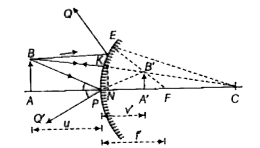Establish the relation 1u+1v=1f for a convex mirror.

Now, triangles A. B. F. and ENF are similar. Therefore,
A.B.NE=A.FNF
As aperture of the concave mirror is small, NF=PF. Also, NE = AB
A.B.AB=A.FPF
Since, the distances are to be measured from pole of the mirror, we have
A.F=PF−PA.
∴A.B.AB=PF−PA.PF...(i)
Also, triangles ABP and A.B.P are similar.
Therefore, A.B.AB=PA.PA ....(ii)
From Eqs. (i) and (ii), we have
PF−PA.PF=PA.PA ....(iii)
Applying sign conventions, we have
PA= -u (distance of object is measured against the incident light)
PA. = +v ( distance of image is measured along the incident light)
PF = + f ( focal length of convex mirror is measured along the incident light)
Substituting for PA, PA. and PF in Eq (iii), we have
+f−(+v)+f=+v−uorf−vf=−vu
or 1−vf=−vuor1v−1f=−1u
∴1v+1u=1f
Similar Questions
Knowledge Check
The graph between 1v and 1u for a concave mirror looks like.
A B
B C
C D
D
What is f in mirror formula 1u+1v=1f ?
Adistance of objectBdistance of imageCfocal lengthDNone.By Plotting 1v verus 1u focal length of a convex mirror can be found .
ANo as it forms a virtual imageBYes only if scale is largeCYes only if scale is smallDYes only if aperture is small
By Plotting 1v verus 1u focal length of a convex mirror can be found .
View SolutionThe focal length of a mirror is given by 1v−1u=2f. If equal errors α are made inmeasuring uandv. Then relative error in f is
View SolutionThe focal length of a less is given by the formula 1f=1u+1v. Make f as the subject of the formula.
if u=20cm and v=30, then find f.
The following steps are involved in solving the above problem. Arrange them in sequential order.
(A) Given 1f=1u+1v
(B) ⇒f=uvu+v
(C) f=20×3020+30=60050=12cm.
(D) ⇒1f=v+uuv
View SolutionThe focal length of a less is given by the formula 1f=1u+1v. Make f as the subject of the formula.
if u=20cm and v=30, then find f.
The following steps are involved in solving the above problem. Arrange them in sequential order.
(A) Given 1f=1u+1v
(B) ⇒f=uvu+v
(C) f=20×3020+30=60050=12cm.
(D) ⇒1f=v+uuv
View SolutionThe focal length of a less is given by the formula 1f=1u+1v. Make f as the subject of the formula.
if u=20cm and v=30, then find f.
The following steps are involved in solving the above problem. Arrange them in sequential order.
(A) Given 1f=1u+1v
(B) ⇒f=uvu+v
(C) f=20×3020+30=60050=12cm.
(D) ⇒1f=v+uuv
View Solution
